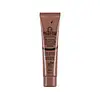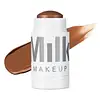What's inside
What's inside
 Key Ingredients
Key Ingredients

No key ingredients
 Benefits
Benefits

 Concerns
Concerns

No concerns
 Ingredients Side-by-side
Ingredients Side-by-side

Ricinus Communis Seed Oil
MaskingC12-15 Alkyl Benzoate
AntimicrobialHelianthus Annuus Seed Oil
EmollientHelianthus Annuus Seed Wax
Skin ConditioningCoconut Alkanes
EmollientSilica
AbrasiveEuphorbia Cerifera Wax
Kaolin
AbrasiveMangifera Indica Seed Butter
Skin ConditioningCitrus Aurantium Dulcis Peel Wax
Skin ConditioningPrunus Armeniaca Kernel Oil
MaskingCoco-Caprylate/Caprate
EmollientBis-Stearyl Dimethicone
EmollientParfum
MaskingHydrogenated Vegetable Oil
EmollientIsopropyl Titanium Triisostearate
EmollientTocopheryl Acetate
AntioxidantSorbitan Tristearate
EmulsifyingCI 77891
Cosmetic ColorantIron Oxides
Ricinus Communis Seed Oil, C12-15 Alkyl Benzoate, Helianthus Annuus Seed Oil, Helianthus Annuus Seed Wax, Coconut Alkanes, Silica, Euphorbia Cerifera Wax, Kaolin, Mangifera Indica Seed Butter, Citrus Aurantium Dulcis Peel Wax, Prunus Armeniaca Kernel Oil, Coco-Caprylate/Caprate, Bis-Stearyl Dimethicone, Parfum, Hydrogenated Vegetable Oil, Isopropyl Titanium Triisostearate, Tocopheryl Acetate, Sorbitan Tristearate, CI 77891, Iron Oxides
 Reviews
Reviews

Ingredients Explained
These ingredients are found in both products.
Ingredients higher up in an ingredient list are typically present in a larger amount.
Ci 77891 is a white pigment from Titanium dioxide. It is naturally found in minerals such as rutile and ilmenite.
It's main function is to add a white color to cosmetics. It can also be mixed with other colors to create different shades.
Ci 77891 is commonly found in sunscreens due to its ability to block UV rays.
Learn more about CI 77891Helianthus Annuus Seed Oil is the oil derived from the seeds of a Sunflower. Sunflower seed oil is non-fragrant. It is an emollient, meaning it helps to soften the skin.
Sunflower seed oil contains many fatty acids. The fatty acids found in sunflower seeds include (from highest amount to least): linoleic acid, myristic acid, palmitic acid, stearic acid, arachidic acid, oleic acid, and linolenic acid.
These fatty acids help the skin create ceramides. Ceramides play a role in repairing the skin barrier.
Helianthus Annuus Seed Oil helps moisturize the skin. This in turn helps the skin look more rejuvenated and smoother.
Sunflowers are rich in vitamin E.
Historians believe Indigenous cultures of North America domesticated sunflowers before corn. Thus they relied on sunflower oil for a variety of uses. One such use is moisturizing skin and hair.
Sunflower seed oil may not be fungal acne safe. We recommend speaking with a professional if you have any concerns.
Learn more about Helianthus Annuus Seed OilRicinus Communis Seed Oil is the INCI name for castor oil.
Castor Oil helps moisturize the skin. It is rich in a fatty acid called ricinoleic acid. This fatty acid helps prevent moisture loss on the skin. This helps keep your skin soft and hydrated. Ricinoleic acid also has anti-inflammatory and pain reducing properties.
Besides hydrating the skin, castor oil is also used to hydrate hair. By keeping the hair shaft moisturized, breakage is decreased. More studies are needed to show castor oil's effective on stimulating hair growth.
Castor oil is created by cold-pressing castor seeds and then purifying the oil with heat. It was used in Ancient Egypt as fuel in lamps and to help treat eye irritation.
The term 'fragrance' is not regulated in many countries. In many cases, it is up to the brand to define this term. For instance, many brands choose to label themselves as "fragrance-free" because they are not using synthetic fragrances. However, their products may still contain ingredients such as essential oils that are considered a fragrance.
Learn more about Ricinus Communis Seed Oil